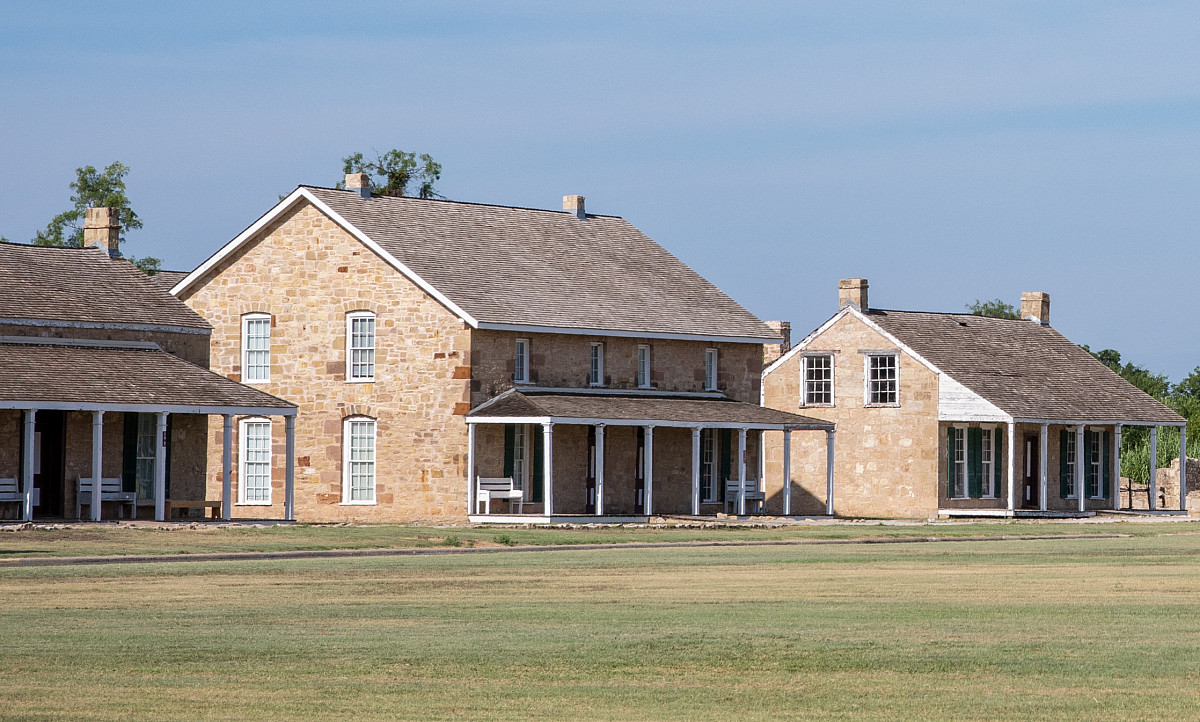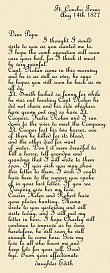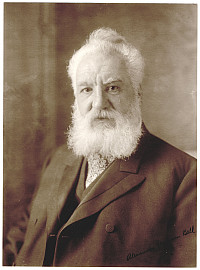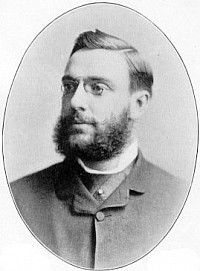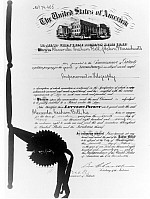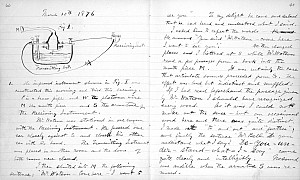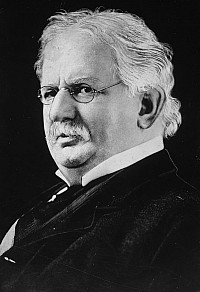The E.H. Danner Museum of Telephony is located in Officers’ Quarters No. 4 at Fort Concho National Historic Landmark in San Angelo. The museum opened on July 13, 1990, and contains over 100 telephones and other equipment related to the history of the telephone.
By viewing this website, you will see early telephones and how technology has changed through the years. You will learn how different phones worked and the impact they have made on people’s lives. You can investigate the telephone’s role in world events – and meet some of the prominent people who were involved in the industry.
After visiting our site, we hope you will imagine what the phones of the future might look like, how people will communicate in the future, and what changes are still to come.
History of the Telephone
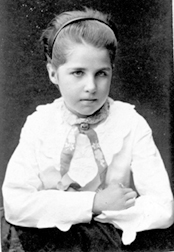
Edith Grierson
Edith Grierson was 9 years old when she moved with her family to the frontier of Texas. Her father, Benjamin H. Grierson, was in the military and served as post commander of Fort Concho in West Texas from April 1875 to July 1882. Col. Grierson commanded the 10th Cavalry, a unit known as the Buffalo Soldiers.
Since there were no schools, the Griersons brought with them a cousin, Olive McFarland, to serve as governess for the children. Olive returned home in 1876, and another cousin took her place.
Dances were a favorite form of entertainment at Fort Concho. The Griersons held dances or hops at their home on special occasions while other dances were held in the mess halls. Edith loved to dance, and her mother often described the hops in her letters to her friends back in Illinois.
The children at Fort Concho had numerous diversions to entertain them. Edith enjoyed needlework, but she also had a pony she loved to ride. Her brothers, Robert, Harry, and George, built bird traps and went hunting and fishing with the soldiers.
Edith and others at the fort had to communicate with family and friends through letters. Fort Concho was on the San Antonio-El Paso Mail route.
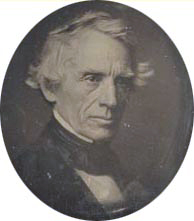
Samuel Finley Breese Morse
The telegraph was invented by Samuel Finley Breese Morse in the 1840s. He had found the first practical use for electricity - even before the light bulb and the telephone were invented!
On January 6, 1838, Morse and his partner, Alfred Vail, sent the first “message” on three miles of wire stretched around a large room. A month later Morse demonstrated the telegraph before President Martin Van Buren in Washington. In 1843 Congress appropriated $30,000 to build an experimental telegraph line from Washington DC to Baltimore.
On May 24, 1844, Morse demonstrated the telegraph to members of Congress. He was seated in the Capitol in Washington DC and tapped out his famous message: “What hath God Wrought?” The message was flashed to Alfred Vail at the railroad depot in Baltimore. The age of telecommunications had begun.
Within ten years, 23,000 miles of wire crossed the country. The telegraph greatly affected the development of the American West. Railroad traffic was improved by the telegraph as was industry and the military.
By October 1861 telegraph wires united the nation. The first transcontinental telegram was sent to President Abraham Lincoln assuring him that California would “stand by the Union on this, its day of trial.”
Telegraph service to Texas first began on a very limited basis in 1854. In the early days, wires were strung from treetop to treetop. Western Union Telegraph Company began operating in Texas in 1866, and by 1870 there were an estimated 1,500 miles of telegraph wire in Texas. At this time telegrams cost a quarter for distances under 25 miles. In 1876 a military telegraph line linking the San Antonio post with other army posts was completed.
Pony Express
The Pony Express operated for only a short period of time: April 1860 - October 1861. But despite its short life, the Pony Express gave rise to one of the most colorful episodes in the history of the American West.
The Pony Express was a mail delivery system using horse and rider relays. The route went between St. Joseph, Missouri and Sacramento, California. There were 157 stops on the 1,800-mile route. The riders changed horses six to eight times between stations. The most famous of the Pony Express riders was William Cody, known as “Buffalo Bill” Cody.
The Pony Express was a financial disaster and ended two days after the transcontinental telegraph line was completed.
Stage Coach
Between the years of 1851 and 1881, United States mail and passengers were carried between San Antonio and El Paso by several different contractors: Henry Skillman, George Giddings, James Birch, Bethel Coopwood, Benjamin Ficklin, and Francis C. Taylor.
After the Civil War, Ficklin managed the field operations. This was similar to the job he had held in establishing the Pony Express. Ficklin reinvigorated the line, changed the route, and set up branch routes. The line now traveled north to the Middle Concho River near Fort Concho and then west to Fort Stockton.
Ficklin died in 1871, and Taylor took over. Taylor named the little village that had sprung up near the Middle Concho stage stop, Benficklin, in honor of his friend and partner. The coming of the railroad put the stage lines out of business.
Bell and Watson
In 1876 an accident in Alexander Graham Bell’s home changed how people live and interact with one another. Bell, a native of Scotland, moved with his family to Boston in 1871. Bell met Thomas A. Watson, a young machinist, and the two worked together on several experiments. On March 10, 1876, Bell and Watson had a breakthrough. The men were in separate rooms in the house. Bell spilled battery acid on his pants and said, “Mr. Watson, come here. I want you.” Watson, who had been listening to the receiving telephone, heard Bell’s cry and rushed down the hall. This event marked the birth of the telephone.
Thomas Watson started working with Alexander Graham Bell in 1874. Watson was only 22 years old when he heard Bell speak to him over the telephone. Bell wanted people to answer the phone “Hoy! Hoy!” as if calling a ship. Watson thought people should answer “Hello”. Watson’s idea took hold.
Watson added several of his own important ideas to the telephone. One was the crank-activated magneto ringer that gave the telephone its ring. He was just 25 years old when he resigned from the telephone company.
Patent No. 174,465, the most valuable patent ever issued by the U.S. Patent Office, was filed February 14, 1876. The race to file the first telephone patent was tight. Another inventor, Elisha Gray, was on the verge of inventing the electric speaking phone. Gray arrived at the patent office just three hours after Bell’s patent was filed. Gray was going to file a caveat, a formal declaration stating the inventor’s intention to file a patent on an idea yet to be perfected. On the basis of its earlier filing time and on the subtle distinctions between caveat and an actual patent application, the U.S. Patent Office awarded Bell the patent for the telephone.
Almon B. Strowger
Almon B. Strowger was an undertaker in Kansas City, Missouri who was convinced that the operators in town gave busy signals or wrong numbers when potential customers tried to call him, hurting his business. He decided to invent a switchboard that would eliminate the operator. He patented the first automatic dial system in 1891.
The first system had the capacity to serve 99 telephones. To call the number 99, each button had to be pressed 9 times. The first Strowger Automatic Telephone Exchange was built in La Port, Indiana. Strowger sold his patent for $2 million and quit the undertaking business.
How the Phone Works
Bell’s experimental telephones operated much like two cups connected with string. When speaking, there is air movement that can not be seen, but it can be heard. This movement of air when speaking into a cup causes the bottom portion of the cup to move in and out. The in-and-out movement makes the attached string move and causes the bottom of the other cup to move in and out. This movement produces sound heard by the listener.
Designing an experimental telephone that had battery acid as a power source and used wire rather than string gave Bell and Watson a better device for transmitting sound waves. Bell’s experimental telephone had a thin device inside called a diaphragm that moved like the bottom of the cup when struck by sound waves. The movement of the diaphragm increases and decreases the electrical current being sent to the other telephone. The electrical current made the diaphragm in the other telephone move producing sound.
Today sound waves can be transmitted over a greater distance without using wires to connect telephones. Still, at the heart of every telephone today, is the same basic function: to transmit sound waves over a distance.
John Y. Rust
John Y. Rust purchased the existing phone operation in San Angelo in 1899 for $5,000. He and his brothers formed the San Angelo Telephone Company. At the time of purchase, there were 260 subscribers who used cigar boxes with crude transmitters and receivers attached. Each phone had a separate line. The cost of telephone service was $3.00 for businesses and $1.50 for residential customers. Those prices did not change until 1919.
Rust and his brothers made many improvements. By 1907, San Angelo had changed from magneto to common battery, and the business grew 10-fold, numbering between 750 to 800 subscribers.
Whoop and Holler Systems - Pioneers of the Hollow Wire
In the late 1800’s telephone services were in demand for smaller towns, communities, and rural areas. Many farmers pooled their resources to purchase telephone equipment and frequently used existing barbed-wire fences for telephone lines. Because rain interfered with the flow of current on these uninsulated lines, such farm networks were frequently called “whoop and holler” telephone systems. Some 6,000 grassroots companies were established between 1894 and 1897, giving birth to the free-wheeling “independent” telephone industry.
Good Telephone Manners
Speak directly into the mouthpiece, do not fiddle with the mouthpiece or insert a foreign object into it. Speak slowly and lowly, thereby avoiding any unpleasant hissing, whistling or slurring. When finished with conversation, put earpiece down gently, without dropping and always, remember to treat another person’s ear as you would have that person treat yours. Early telephone directories were so small that they were often published in the newspaper.
Magneto vs Common Battery
Magneto: talking power was supplied by two dry-cell batteries on the customer’s end. Customers created signaling power by turning a hand crank on the telephone box. The operators were alerted to a call when a metal hook holding a drop in place retracted and released the drop. The buzzing sound signaled someone wanted to make a call.
Common battery: All power for the customer’s phone and the switchboard was located in the central office. When the customer took the receiver off the hook, a lamp would light up on the switchboard to signal the operator to make a connection.
Theodore Vail
Theodore Vail, President of American Telephone and Telegraph (AT&T), dreamed of creating a transcontinental phone system. In 1913 AT&T dispatched teams of workers - through blizzards, lightning, and rough terrain - to string a continuous line of telephone wires between the coasts. The lines were joined on 17 June 1914 in Utah. The longest line stretched 3,505 miles.
Independent operators owned the telephone exchange in towns and other small areas but often did not have access to the toll network. Long distance lines were controlled by Bell; independents were usually denied access or required to pay high prices to use the toll lines. There was no regulation of the problem between independents and the mighty Bell until 1913 when the government intervened and an agreement was finally reached. The Bell system, or AT&T, agreed to let independent telephone companies connect their exchanges to the long-distance toll network.
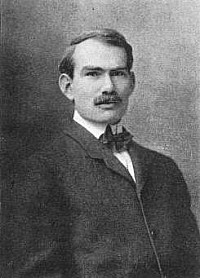
Lee De Forest
Lee De Forest invented his version of the regenerative circuit in 1912. It amplified the volume of radio or telephone, which made long-distance calling clearer.
Dr. Lee De Forest patented the vacuum tube, a device that boosted transmission and made it possible to call over long distances. People no longer had to depend on the telegraph to send long messages although there were still some problems. In San Angelo, the first toll line terminated on the wall of the old Landon Hotel. In the early days of the system, persons who wanted to place a long distance call had to go to the hotel and often had to wait a day for the call to be completed.
World War I
During the war, 233 U.S. women were part of the Signal Corps Female Telephone Operators Unit that went overseas. Many worked under combat conditions close behind the lines.
The 412 Signal Corps Battalion, comprised of telephone employee volunteers, was trained at Camp Morse in Leon Springs, TX. They arrived in France 26 January 1918 and began building a telephone and telegraph line that stretched 400 miles across the field of battle. Telephone engineers developed two-way air-to-ground radio equipment in 1917, and American pilots used it in 1918 combat in France.
Operators were among the first to know when World War I ended. An operator in Gonzales, Texas was preparing to go off duty. Suddenly, news began to make the rounds that the war was over. The operator decided to stay in case there was further news. As the night went on, church bells began to ring out and lamps began to light up on the switchboard. The two operators took plugs in both hands and began answering the calls with the words “Germany has sued for peace.”
Telephone Service Grows
Customers were charged a flat rate. It was much easier to charge everyone the same price instead of trying to figure out who used what part of what line over what distance for how long and for how much. Flat rates were determined by the amount of money the owner needed to keep the business going. This was known as a revenue requirement. The amount was divided by the total number of customers in the exchange. Business customers paid twice the monthly charge as residential customers.
Bell and Watson reenacted their first telephone conversation at the Pan-American Exposition in San Francisco in 1915. Bell, in New York, called Watson and said, “Watson come here, I want to see you.” Watson in San Francisco said, “I would be glad to come, Mr. Bell, but it would take more than a week.” Long distance service became available immediately.
Number Please - How may I connect your call?
Artie Priddy was a switchboard operator in the 1920s. She worked six days a week, nine hours a day and every other Sunday and made 75 cents an hour. Each morning she would call her “wake up” list. The list was made up of subscribers who had called in the night before and told her what time they wanted to be called the next morning. Priddy was their personal alarm clock! Priddy and her fellow operators were often called “Hello Girls”. Operators were required to dress as ladies. Heels, hose, high necklines and low hemlines constituted modest dress. Employees were sent home for improper attire, too much makeup or exotic hairdos.
The switchboard was marked with numbers and jacks on a party line were marked with paints of different colors.
- Red paint = Disconnect
- Yellow paint = Change
- Green paint = A new number
- No paint = Straight-line number, not a party line.
Party lines also had a number. On a four-party line, all four parties would have a different letter. Each party line also had a different ring. “Hello Girls” had to keep all of this straight.
New Milestones Reached
“Old Cap” was the first known line truck built to set telephone poles. The vehicle was designed and built by a group from the San Angelo Telephone company, but people from Austin, Lubbock, and Fort Worth came to see it. Its main feature was a derrick that could be raised and lowered from the driver’s seat. Other vehicles in use at the time were operated by hand. “Old Cap” helped to set poles and pull underground cable in San Angelo, Ozona, and Sonora.
John Rust began to prepare for a growing community in 1928 by laying underground cable to accommodate a city of one hundred thousand people. Underground cable was not widely used until the 1920s.
In 1927 commercial transatlantic telephone service to London, England began with a two-way radio. These calls cost $75 for five minutes.
Phone Location in the Home: During the 1920s companies began to locate a telephone inside a house anywhere the customer requested. The kitchen or master bedroom became common choices for the location of the telephone instead of the noisy, open central hall that had been used for years.
How the switchboard Works
Operators provided telephone service for the subscribers and were information centers in small exchanges. In cases of emergency, the operator provided a great community service for the fire department, hospitals, and ambulance service.
How it works: When a customer turned the crank on a magneto telephone, a drop, showing the caller’s line number, fell down just above the caller’s line. The operator took any black cord, plugged it into the caller’s line, pushed back the front key which was in line with the cord, and said, “number please.” She then took the cord which was directly in front of the back cord, plugged it into the called number, and pulled the back key toward her to ring the party’s telephone. When the party answered the connection was complete, and the operator closed the talk key, not listening in - if she was honest.
Clumbsum, Grunts, and Squeaks
Joe Jackson worked on construction crews throughout Texas during the 1930s and 40s. Jackson and his men helped establish telephone service to booming oil towns in West Texas and New Mexico. Jackson and other work crews had to move from town to town quickly and sometimes that wasn´t easy. Jackson rode horseback from Lubbock, Texas to Carlsbad, New Mexico on a job because there were no paved roads between towns.
Setting poles and stringing line was hard work. Digging pole holes was backbreaking, most diggers aspired to become climbers. That promotion usually happened after 3 to 6 months. The new climber received a few pointers about the hooks, along with their straps and pads. He was told how to set his feet at the proper angle to the pole and place the weight on his feet. If it was done properly, the climber´s arms would be straight and he could guide himself to the top with his hands around the backside of the pole. It took a wagonload of poles to lay a mile of phone line.
Joe Jackson worked for the company for 42 years, with 21 immediate supervisors, under seven different company presidents. He held 14 different job titles.
Power of Insulators
Insulators came in every size and shape imaginable. Over 2,200 patents have been granted for insulators. They were used by telephone, telegraph, power and railroad companies. The first insulators had no threads to screw them down on the pole pins. They were mounted by pressing them down on a square of burlap on top of the pins. When the burlap was worn, the repairmen rode the lines by horseback, replacing the worn burlap with new pieces.
Added later were bubbles to the bottoms and skirts to the inside of the insulators. The bubbles helped water drip off faster, cutting down on rust. Skirts kept dust from the pins. Both dust and rust interfered with clear transmission and kept the customers from hearing well.
The Telephone and World War II
Franklin D. Roosevelt learned about Germany´s invasion of Poland and the start of World War II early in the morning over the phone. At twenty minutes to three on the morning of September 1, 1939, a buzzer sounded at the White House switchboard. The sleepy night operator plugged in her line. A voice came, “Paris calling,” and then another voice, strangely sharp and harsh, “May I speak to the President?” … The operator sounded the bell in the President’s bedroom, and the President roused himself quickly and picked up the telephone by his bed. Bill Bullitt called to tell the President that German divisions were deep in Polish territory.
What was striking was the immediacy and informality of talking over the telephone - the two traits which distinguish the telephone from any other form of communication, whether it was a call to a neighbor to trade gossip or call to a President to announce the outbreak of a war.
The War Production Board issued an order in 1942 to limit telephone installations throughout the country during the war. This limit placed the development of local telephone business behind but the telephone became increasingly important.
After the outbreak of WWII, long distance calls increased. Men waited in long lines at military camps to make calls home. Operators in major cities were instructed to ask customers to keep their calls short. The recommended time was five minutes.
Newspaper ads read: “You can give them a lift in more ways than one if you will go easy on Long Distance between 7 and 10 each night. That’s the time many servicemen in the camps are calling home and they’ll appreciate your help in leaving the line for them.”
After World War II the telephone became a necessity for Americans rather than a luxury. As a result, 97,000 telephones were installed in 1947 and 123,000 unfilled orders remained at year-end.
Phones During the Depression
During the Great Depression, many small companies were sold or went out of business. In 1924 there were about 8,000 independent phone companies in the country. By 1934, that total had dropped to only 6,000. Phone companies learned that telephone service was something people could do without in a real pinch. Many companies accepted other forms of payment. The telephone agent in Thalia, Texas began accepting chicken, eggs, butter, and milk as payment for rental due on subscribers’ telephone instruments. Her idea became known as the “Produce Pool,” a method used by many businesses trying to survive the Depression.
Single men who worked for the telephone gave up their jobs so men with families could keep working. Those people with families were given only 3 days of work a week, and their pay slashed.
Throughout the Depression, women who worked for the telephone company were required to quit if their husbands also began working for the company. The company thought if only one member of the family worked, more people might have a chance to make a living for their families.
E.H. Danner - From Lineman to President
E.H. Danner was born in 1903. He started working for the Illinois Telephone Company in Jacksonville in 1928. The man that gave Danner the job told him he would have to start at the bottom. That is just what Danner did. His first job was digging holes and it paid $85.00 per month. During his career, he worked as a ground man, lineman and switchboard man among other positions. Danner became president of the General Telephone Company of the Southwest in 1957. During his forty years, he saw many changes, the most significant being the dial telephone replacing the switchboard. Telephones became a necessity that everyone had in their home.
Housing Boom Equals Phone Shortage
The 1950s experienced a housing boom that telephone service couldn’t keep up with. Builders and speculators usually forgot to check the availability of telephone. This was a problem for new homebuyers and the telephone company. Americans moving anywhere in this country expected telephone service to be there, waiting and ready, never understanding the preparations required to establish service. In some new residential areas, neighbors had to share a pay phone until they received a telephone in their home.
Dial Telephones: Goodbye Hello Girl
Booklets with instructions for using the new dial instruments were sent to telephone customers. One instruction was: Listen for the Dial Tone. The dial tone is a steady humming sound. It lets you know the dial equipment is ready to handle your call. Always wait until you hear the dial tone before you dial.
Not everyone immediately understood how the dial system worked. A customer in Texas called to report that he got wrong numbers every time he dialed anyone. The repairman checked and found no problems with the phone, so he asked the customer to dial someone. The customer decided to dial his neighbor Mr. Jones. The repairman watched as the customer dialed J-O-N-E-S and of course got the wrong number.
The change from operator-assisted calls to dial service was an emotional task for some. Some operators cried and others were excited. Everyone felt that it was a passing of an era.
Tips for dialing local calls:
- Be sure you know the correct number.
- Lift the receiver and wait for dial tone (steady humming) before dialing.
- Dial each letter and each number carefully; being sure that you let the dial spin back freely.
- If the line is not busy, you will hear a “burring” or ringing sound at intervals. It is considered a courtesy, to allow a telephone to ring at least ten times (which equals approximately one minute) before assuming the person is not at home. This ringing will continue until you hang up your receiver or until called party answers.
- If the number you are calling is busy, you will hear a “buzz, buzz, buzz” which is known as a busy signal. The signal indicates that the line you are calling is in use and you should hang up and call again later.
In 1957 Sherman became the first independent telephone exchange in the state of Texas to provide subscribers with the capability to dial their own station-to-station long distance calls - this new era brought a new phrase - area code.
1960 marked the beginning of the All Number Calling system which used seven-digit telephone numbers rather than traditional letter prefixes and number.
In 1968 the three-digit 911 number was reserved for emergency reporting throughout the US.
The first undersea telephone cable was laid on the bottom of the North Atlantic in 1955. This cable provided better telephone service between Great Britain, Canada, and the United States.
James L. (Rocky) Johnson
Moving into the era of voice, data and video communications.
James L. “Rocky” Johnson started with Southwestern Associated Telephone Company as an accounting clerk in the general office in 1949 Lubbock, Texas. Ten years later he became the controller of General Telephone Company of Michigan. Johnson returned to the southwest company in 1966 as vice president-controller and treasurer. Three years later he became vice president and controller, GTE Telephone Operations. Johnson was later elected president of the GTE Telephone Operating Group. In 1986 Johnson was elected president and chief operating officer of GTE Corporation.
Mr. Johnson headed GTE’s Telephone Operating unit during a time that saw the telecommunications industry go through historic changes. He guided GTE through the repercussions that resulted from the divestiture of the Baby Bells from AT&T and the deregulation of the telephone industry. In April of 1998, he was appointed GTE’s Chairman and CEO. Mr. Johnson led GTE from the business of voice communications to the new industry of voice, data, and video communications.
Celebrating 100 Years of Changes
The telephone reached its 100th birthday on March 9, 1976. In 100 years the phone had changed dramatically. It went from a heavy black phone in people’s hallway to an instrument that could be used outside, in a car or in the air. Technological changes over the past 100 years were awesome.
Cordless phones became available about 1980. The early models were primitive. The phones had a good range but the sound quality was bad. There was often the problem of neighbors being able to hear each other’s conversations. The Federal Communication Commission (FCC) made changes in 1986 by increasing the phone frequency. The higher frequency meant less noise. Callers were also less likely to hear other people’s conversations. By 1990 some cordless phones had a much greater power. These phones were much clearer and had better distance than ever before. Phones now had 100 channels to choose from which meant less crowding. Around 1994 digital cordless phones appeared. A digital phone had increased clarity and was impossible for radio scanners to pick up this frequency to listen to other’s conversations. The next major advancement came in 1998 when the frequency was again increased. The phones provided great clarity and better distance. Users could walk around the block with no noise and with maximum security.
Cellular phones, launched by Motorola in 1977, was an experimental phone system designed to employ both portable and vehicular phones. A GTE Mobilnet subsidiary was organized as the company’s entry into the new “cellular” mobile radio telephone service business.
The term “pager” was first used in 1959 and referred to a Motorola radio communications product, a small radio receiver that delivered a radio message individually to those carrying the pager device. The first pager, as we know them today, was Motorola’s Pageboy I, introduced in 1974. The pager had no display and could not store messages, but it was portable and notified the wearer that a pager message had been sent. By 1980, there were 3.2 million pager users worldwide. By 1990, wide-area paging had been invented and over 22 million pagers were in use. That number shot up to over 61 million in 1994.
The first Airfone call was placed in October 1984. Since that time millions of calls have been placed from the air. The service is available from on most major airlines and serves as the business traveler’s 35,000-foot lifeline.
Phone Mart: Pick Your Phone, Pick Your Color
In November 1973, the pilot program for a Phone Mart was put into place in Irving, Texas. The Phone Mart was designed to be a supermarket of communications services and equipment. The concept was an overnight success. It gave the customers a chance to actually see what telephone options they had, to place orders for the service selected, and to take the telephone instrument home and plug it in.
Evolution of the Telephone Industry
After the invention of the telephone, the Bell system expanded quickly across the nation but without covering the whole country. Bell mainly provided service in metropolitan areas because they were more profitable and the easiest to serve. Independent telephone companies developed to serve suburban and rural districts or less densely populated areas. The independents wound up with the less-profitable areas where customers were fewer and farther apart. The Bell system had most of the telephone market in the country, especially long-distance traffic.
In the early days of the telephone industry, there was so much competition that telephone service bordered on chaos. There were often two or three telephone companies in the same town. If you didn’t subscribe to the same company as a friend down the street, neither of you could call the other. There were two or three sets of poles and wires running down the street. That’s what brought the government into the picture in the first place as the regulator of the telephone industry. It brought order out of chaos, established franchised territories, and injected some degree of fairness and equity into the rate structure.
In 1980 the Federal Communication Commission (FCC) made an important decision. It decided AT&T needed to separate its local and long-distance services. As a result, the Bell system divested itself. AT&T kept the long distance part of the business, its research organization, and its manufacturing operations. On January 1, 1984, AT&T operating company was divided into seven large regional companies, known as “Baby Bells”.
There are fewer telephone companies around today. In 1914, the state of Texas had some 529 telephone companies; at the beginning of 1990, there were 60. Consolidations and mergers have greatly reduced the number of companies, even as the numbers of customers served has continued to grow.
Weathering the Storm: Wind, Ice, and Rain
The weather has had serious effects on communications since the beginning of telecommunications; it didn’t matter if it was wind, rain, flood, tornadoes or ice. Many in the telephone industry have always considered the restoration of service after a weather event a success story. Sandstorms of the 1930s reeked havoc on telephone lines. Sandstorms generated so much static on telephone lines that long-distance conversations were often impossible.
Water has serious effects on telephone service as was apparent in September 1936 when the Concho River in San Angelo flooded. Debris, including houses swept from their foundations, floated down the main channel of the river and piled up against the Chadbourne Street Bridge. This caused the river to back up into the downtown area and threatened the Central Office of the San Angelo Telephone Company.
Telephone crews sandbagged the building and equipment inside against the rising water. Batteries were kept charged with portable generators since all commercial electrical power had been lost. Workers laid off because of the Depression were called back into work. The flood caused 75% of the telephones in San Angelo to be out of order due to wet or broken cables and washed out poles. Service was restored in five working days.
Underground cables that had been installed by John Rust in the 1920s were flooded and destroyed. Telephone crews gathered as much equipment as they could find. They spent three weeks working 14-18 hour days repairing the damage.
Long distance lines were severely affected in 1949 when Texas experienced a severe ice storm. Lines were coated with ice throughout Texas and into New Mexico. Telephone poles and wires were breaking faster than they could be replaced. The freezing drizzle continued for six weeks. The rain coated the wire with ice, which melted slightly and then refroze until the load of ice was several inches thick. Poles and lines tumbled to the ground under the weight. Miles and miles of telephone line and poles had to be replaced. It was weeks before normal service was restored.
In 1953 the Lakeview subdivision of San Angelo was struck by a severe tornado. The tornado hit the local high school and left a half-mile wide swath of destruction four to five blocks long. Installers and trouble-shooters immediately began setting up temporary service and repairing lines for the Associated Press and for relief agencies moving into the area. The tangled mass of wires, poles, and cables was removed from the streets. Six thousand of the 18,000 phones in service in San Angelo were silenced. Some two hundred phones were blown away and destroyed. Operators and other telephone workers had to deal with the flood of emergency calls. Service was restored and facilities rebuilt.
GTE + Bell Atlantic = Verizon
The history of GTE Southwest (GTESW) officially began in 1926, some fifty years after the beginning of the United State telephone industry. GTESW was formed from many small telephone companies put together at different times. GTE acquired the San Angelo Telephone Company in 1953. The company president wanted a central Texas location for the headquarters of General Telephone Company of the Southwest. The headquarters had been moved to Dallas from Lubbock in 1949, even though the company’s service areas were predominately in the western and southwestern portions of the state. After the acquisition of the San Angelo Company, the headquarters of the General Telephone of the Southwest moved into a newly constructed general office building in San Angelo. San Angelo remained a significant part of the GTE company.
GTE became the company symbol in January 1971. The new symbol was clean and set in a typeface specially designed for the company and placed inside a rounded rectangle.
In the fall of 1977, a new slogan was created to reflect that gee-whiz feeling: “Gee! No, GTE!” The slogan also worked well with the new technology that GTE was creating and working with.
In June of 2000, the federal government approved an $80 billion merger between GTE Corporation and Bell Atlantic. The two companies merged together to become Verizon communications.
The new name of the company, Verizon, was selected from more than 8,500 names. The new name comes from the Latin word “veritas,” which means truth and also connotes certainty and reliability, and “horizon,” which signifies the possibilities ahead.
Wireless Phones, Internet…
Wireless allows people to be completely mobile. They can be reached anywhere in the car, supermarket or hair salon. Phones can do things that people couldn’t even imagine 25 or 50 years ago. Users can use their phone as a web browser, a calculator or calendar. Gone are the days when telephone technology stayed in place for twenty years or more. The pace has quickened and changes have come fast.
Phones of the Period
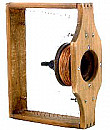
Alexander Graham Bell Gallows Phone (1876)
One of the earliest telephones designed Alexander Graham Bell and made by Thomas Watson. This phone was used as a transmitter and a receiver.
How it works: The wooden frame is mounted with a harmonic receiver and a tightly-stretched parchment drumhead. The free end of the steel receiver spring is fastened to the center. A mouthpiece is arranged to direct the voice against the other side of the drumhead. This forces the spring to follow the vibrations of the voice and, in this way, generate voice-shaped electric undulations.

Arthur Kruger Company Reproduction of Bell Telephone (1876-1890)
A fancier model of the Gallows phone. It is the second model used by Bell and his assistant, Watson.
Arthur Kruger Company Reproduction of Bell Telephone (1876-1900)
This is a replica of the phone Bell demonstrated this in Philadelphia in 1876 at the Centennial Exposition. It was used to send and receive messages. When the Emperor of Brazil saw the phone he exclaimed, “My god it talks!

Arthur Kruger Company Liquid Transmitter Replica (1876-1900)
Bell and Watson were experimenting with a phone like this when Mr. Bell spilled acid on his pants and Watson heard him yell for help.
How it works: When one spoke into the top, it vibrated a drum. The needle moved in a small cup of diluted Sulphuric Acid which acted as the agent to vary electrical currents and transmit sound.

Blake Manufacturing Company Blake Transmitter (1878-1890)
Francis Blake invented this solid carbon transmitter. It transmitted the voice more clearly than earlier telephones.
Western Electric Magneto Wall Phone Model # 21 (1898 to mid-1930s)
This phone was used for party line communications. This phone introduced the “solid back” transmitter of 1890. The Bell system was able to improve the transmission and began to replace the Blake transmitter.
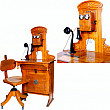
Gray Telephone Company Desk Paystation (about 1898)
In hotel lobbies, traveling salesmen called upon clients during the day and at night placed customers’ orders on this type of paystation. Money slots accommodated nickels, dimes, quarters, half-dollars and dollars.
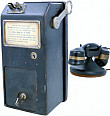
Western Electric Paystation Coin Box (1899 and after)
Called a one-arm paystation because the lever (or arm) on the side of the box had to be pulled down to collect each coin and then allowed to return before another coin could be deposited. The one coin slot accepted nickels, dimes and quarters. The operator had no way of returning the coins once they were deposited, so the customer had to wait until the operator asked for coins in the correct denominations.
Western Electric Magneto Wall Type Paystation (1890 and after)
This phone was used for coin-operated communications.

Gray #11 or #20 Com Box mounted on Kellogg Candlestick Phone (1876-1900s)

Strowger Early Dial Wall Type Telephone (1897 and after)

Western Electric Grabaphone #19 (1895 and later)
Bell bought a major interest in Western Electric, and a year later it became the manufacturer of Bell Telephones and other equipment. This fine handpiece, made less than twenty years after the Gallows frame telephone, is an example of Western Electric’s craftsmanship.

Kellogg Desk Set with French Handset (1902 and after)
This American version of the French-style telephone was considered quite fancy and very stylish. The transmitter and receiver were in one handset. The upright, or candlestick, was to accept the new continental handset. In 1904 the Bell System used a few “French” telephones for experimental reasons. In 1907, its new chief engineer, John J. Carty, recalled all the experimental desk sets because the French handsets cost somewhat more than other desk sets. Carty was under strict orders to cut expenses to the bone. The French style desk sets were not available again until 1927.

S.H. Couch Company 50 Station Selector Signaling Telephone (1900 and later)
S.H. Couch Autophone was used to signal up to 50 stations, primarily on an intercom basis. The longer of the two levers was used similarly to a “finger-stop” on a dial telephone. To call station 19, the caller moved this lever to position 19 then turned the smaller lever to the right until it reached the longer lever, which prevented it from going any farther. When the caller let go of the smaller lever, it returned to its position at the top. The caller then buzzed the called station by pressing the small button to the right of the stem next to the letter A.
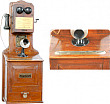
Gray and Kellogg Wall Cabinet Magneto Paystation (1904 and later)
The Gray Telephone Pay Station Company made the backboard and the coin collector device. The various telephone operating companies mounted whatever type of ringer box they wanted as long as it was compatible with their system. It could be a magneto, like this one, or common battery whereby all you had to do to get the operator was lift the receiver. The different coins made different sounds when deposited, letting the operator know what each coin was. Quarters made a gong noise, a dime was two chimes and a nickel was one chime.
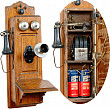
Kellogg Magneto Wall Telephone (1900 and later)
Called the cathedral top and picture-frame type because of the shape of the top and the rectangular groove in front of the box. The small black cylinder at the center of the top was a lightning arrestor. When the line was struck by lightning, this would divert the high voltage to a wire connected to the ground, protecting other wires and coils in the telephone from being burned by the excessive current.
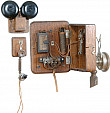
Kellogg Common Battery Grabaphone (1906 and after)
A loud ringing gong provided telephone service in a noisy location. Kellogg Magneto Wall Telephone
Kellogg Magneto Wall Telephone (1908 and later)
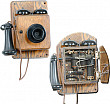
Kellogg Common Battery Wall Telephone or Hotel Phone (1906 and later)
Frequently referred to as a “hotel phone” although this phone was found in many homes and businesses.

Vought-Berger Company Magneto Ceiling Telephone (about 1900)
The telephone hung from the ceiling and the batteries and wires were placed in the ceiling. When the customer pressed the hook-switch in the handpiece and pulled the cord over the pulley, enough power was created to cause a shutter to drop on the operator’s switchboard. She placed the call. As long as the switch was pressed, parties could talk. Ring-back was required to signal call completion.

L.M. Ericson and Company Magneto Wall Telephone (1905 and later)
This European telephone was capable of making and answering calls on two different lines by turning the metal handle below the handset to the left or to the right. One set of bells was connected to one of the lines and the other set to the other line.
The round windmill-looking device a the top was used to determine resistance on the lines. When the crank was turned, the “windmill blades” would turn about 30 degrees to the right, exposing a white surface underneath, which indicated resistance on the line. If the blades did not turn, there was no resistance on the line, indicating that there was a break in the line very near the location of the telephone.
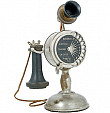
Automatic Electric Candlestick Dial Telephone (1905 and later)

Western Electric Chrome Plated Upright Desk Stand Telephone (1904 and later)

L.M. Ericson and Company Common Battery Handset (1907 and later)

Stromberg Carlson-Gray Magneto Wall Mounted Paystation (1900 and after)
Known as the shield, this distinctive piece of equipment served as the coin collector and was used primarily in conjunction with magneto telephones. It was believed that this colorful piece of equipment had promotional and advertising value.
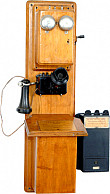
Stromberg Carlson-Gray Magneto Wall Paystation (1900 and after)
This phone was used for coin telephone communications.

Kellogg and Gray Magneto Paystation Service (1900 and after)
This phone was used for coin-operated telephone communications.

Kellogg Common Battery Wall Type Telephone (1916 and later)
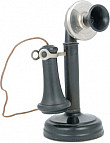
Kellogg Switchboard and Supply Company Common Battery Desk Stand Telephone (1915 and later)
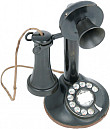
Automatic Electric Candlestick Dial Telephone (1916 and later)
Theodore Gary purchased Automatic Electric Company in 1919, developer of the dial-operated automatic system, which replaced manual connections by the telephone operator. Automatic Electric was also the largest telephone manufacturer in the United States.

American Electric Throw Away Intercom Telephone (1918)
The parts are crimped together and the telephone has no screws.

Automatic Electric Magneto One-Unit Desk Telephone (1925 and later)

Automatic Electric Type 2 Desk Dial Telephone (1920 and later)
Dial telephones began to appear in the larger Texas towns by 1921. Three Dallas central offices converted their technology to dial switching.

American Electric Monophone (1920)
Two-piece desk set used in magneto or common battery exchanges

Kellogg Bell Box used with Desk Stand Telephones (about 1920 and later)
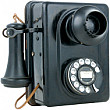
Automatic Electric Wall Type Dial Telephone (about 1922 and later)

Western Electric Common Battery Wall Telephone (1921 and after)

Western Electric and Gray Common Battery Wall Paystation (1921 and after)

Gray Telephone Type 75 Dial Paystation (about 1925 and later)
The three coin slot telephone remained a fixture until the 1960s.
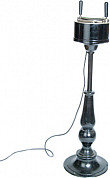
Calculagraph
This device was used to time long distance calls.
How it works: To start timing, the right lever was pushed back, then pulled forward. The left lever was pulled forward to mark call completion time.
Automatic Electric Desk Type Dial Monophone (1934 and later)

Automatic Electric Common Battery Wall Type Monophone (1935 and later)
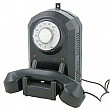
Automatic Electric 50 Wall Phone (1930s)
The first of this type was manufactured in the 1930s. The type 35A actually predated the type 50. It did not have the vent openings on the side, only the bottom. Later models did have the vents on the sides so the customer could hear the bell better.

Automatic Electric Type 40 Desk Type Dial Telephone Monophone (1939 and later)

Automatic Electric “Convenience Phone” (1940 and later)
This phone was capable of picking up two lines with a separate hold button for each line. The small button on the right front side of the cradle was used to buzz another extension.
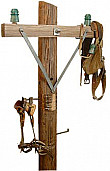
Pole and Equipment
A two-point transposition bracket was used to rotate the wires so noise would not be created in the circuit.

Splicing Tools (1920s through 1935)
These tools were used for twisting open wire lines utilized for toll and rural lines.
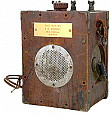
“Handmade Woodpecker” (about 1930)
This machine was used to find shorts and grounds on cable pairs in lead covered cables.

Whitney Blake Company Cable Fault Locator (1940s through 1960s)
Cable splicers and combination men used these to located cable faults (shorts, crosses, grounds and opens.) Two men - one to work the locator and the other to climb the pole, using a grunt box, locator coil, and headset - could identify the type of trouble and its location in the cable.

Yellow pencils (mid-1950s to mid-1960s)
These pencils with wooden knobs in place of erasers were given to the General Telephone customers by its business offices. The wooden knob could be used to dial numbers on a rotary dial telephone but the user was reminded to use the writing end to make a note of telephone numbers.

Automatic Electric Desk-Type Telephone (1959 and later)

Automatic Electric Desk-Type Touch Call Telephone (1968 and later)

Automatic Electric Type 880 Speakerphone (1968 and later).
This phone was used for hands-free communications.

Automatic Electric Desk-Type Styleline Dial Telephone (1969 and later)
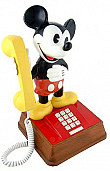
American Telecommunications Designer Mickey Mouse Telephone
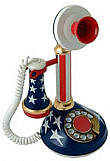
American Telecommunications Designer Candlestick Stars and Stripes

Cellular Phone

Bag Phone
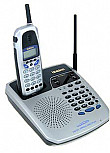
Cordless Phone
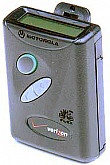
Pager
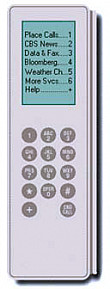
Airfone
Two books were used extensively in the research for this site:
- “The Heritage of Time: The People and Times of GTE Southwest, 1876-1988” by Larry Johnson
- “The History of GTE: The Evolution of One of America’s Great Corporations” by Thomas McCarthy
Creation of this site was a collaborative effort between Verizon, the West Texas Collection and ASU’s Information Technology Department. Special thanks go to the members of the GTE Pioneers Club, who were instrumental partners.
Questions? Contact Us!

